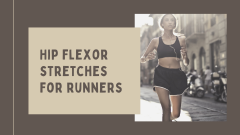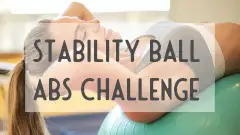To have flat abs, you need to do more than abs workouts. Your abdominal tone depends on having good posture and correct pelvic alignment. Although doing core workouts help with this, there are a lot of other things you can do that will make a difference. Here are 10 top lifestyle and exercise flat abs tips.
Affiliate disclosure: this post contains affiliate links. If you make a purchase via these links I will receive a commission.
10 top flat abs tips
#1 Be more active

It’s not just abs exercises that will help your ab tone. All activity helps to improve posture and core strength, which are key to having good abdominal tone. Try to increase your daily activity as much as possible – see the links at the bottom for ideas to be more active.
#2 Stretch your hip flexors
The hip flexors are the muscles which join the front of the thigh bone to the pelvis. Tight hip flexors are very common and pull the pelvis into a forward tilt and the low back into an exaggerated arch. To have flat abs, you need your pelvis and spine in the neutral position. Try to stretch your hip flexors at least once a day. Here’s one hip flexor stretch, see the links below for some alternatives:

- Get into the position shown, back knee on the floor, front knee bent and directly over the heel.
- Ease the back leg out behind until you feel the stretch in your hip flexors on that leg.
#3 Cut down on wearing high heels
It’s hard to have correct posture in high heels. This is because they affect spine alignment, as the body tries to compensate for being thrown off-balance by the heels. Heel wearers often bend forward slightly and arch their lower backs. This leads to posture problems that don’t go away when they take their shoes off, including a belly “pooch”.
#4 Use a stability ball
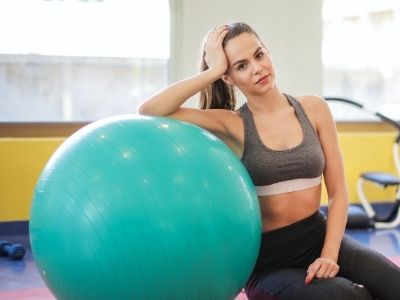
The stability ball (also known as a Swiss ball) is an excellent piece of equipment for improving posture and strengthening the core muscles. There is a wide range of exercises you can use it for. Some of them require good core strength and balance, however many are suitable for beginners.
You don’t need to exercise with the ball to benefit though. Even just sitting on it will help to improve core strength. Because the ball is inherently unstable, your core muscles have to work all the time to stop you from falling off. Sitting on the ball at your desk or to watch TV will help to improve your core without any noticeable effort. Stability balls come in different sizes and it’s important to choose the correct size for your height. You can see a helpful height/size chart in the product info. for this ball.
For a stability ball workout challenge, see the links below.
#5 Do ab hollowing
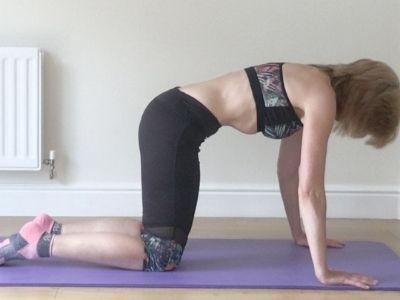
Abdominal hollowing is just sucking the abdominal muscles in – pulling the belly button towards the spine. This strengthens the deep abdominal muscles that pull the abdominal area flat. You can do it in any position – standing, sitting, lying, kneeling. However, doing it in the all-4s kneeling position is good because this makes the ab muscles work directly against gravity. Hold the position for about 5 seconds, then release and repeat 5-10 times each day.
#6 Make sure you maintain neutral pelvis when doing abs exercises
If you’re doing an abs workout, to make sure you’re training the right muscles and not putting strain on your back, you need to keep your pelvis in the neutral position. Follow the steps below to find neutral pelvis, then make sure you maintain it when you’re working your abs.
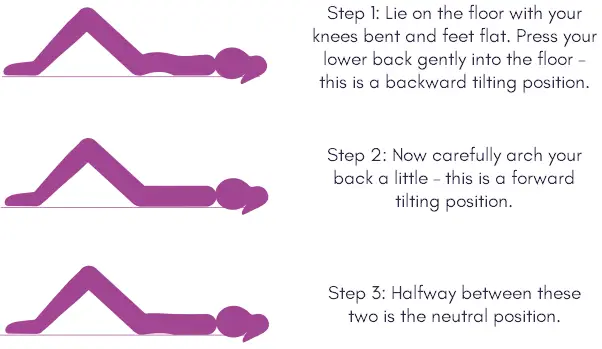
#7 Do standing ab work
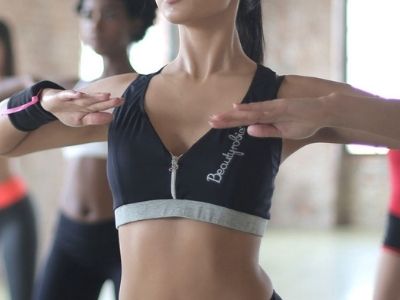
Abs training on the floor has the advantage that you work directly against gravity, but doing standing work challenges the muscles in a more functional way. If you do some standing work, then you’ll train your abs to support your spine and look good when you’re standing and moving around. See the links below for a standing abs workout (waist workout challenge).
#8 Train your pelvic floor too
The core abdominal muscles, muscles of the lower back, diaphragm and pelvic floor muscles all work together. For effective core muscle training, you need to have a strong pelvic floor too. You should always be aware of your pelvic floor muscles and remember to engage them when exercising. If you have weak pelvic floor muscles, or struggle to know if you are engaging them properly, then try using kegel weights.
#9 Do exercises which challenge your balance
Our core muscles work to stabilise us, which means that putting the body into an unstable position gives them more work to do. Exercises which challenge balance include:
- Any exercise where the weight is on one leg, for example knee lifts, side leg lifts, high kicks etc.
- Movements where the weight is on the toes, for example calf raises, squats with heels raised
- Stability ball work (see above)
- Balance board and Bosu work
#10 Do Pilates
The Pilates method is based on several key principles, including:
- Relaxation, breathing and concentration: the mind-body connection is important in Pilates. Relaxation and breathing help to focus concentration on the precise muscle control required to carry out the exercises properly.
- Centring and alignment: The Pilates method focuses on body alignment and core strength. Joseph Pilates was a strong believer that all movement should be supported by a strong “centre” – the body’s core stabilising muscles. The method mainly trains these muscles, but also strengthens the muscles in the back which stabilise the shoulder blades and hold them in place.
- Control, precision and fluid movement: Pilates exercises should always be done with excellent technique, paying close attention to exactly how your muscles are working, but at the same time the movements should be fluid and graceful.
More on flat abs tips
Ab workouts FAQ
The stock answer to this is that you can’t get rid of fat from a specific area. This is repeated frequently and emphatically by almost everyone involved in fitness. Given that it’s the go-to answer, you would think that there’s a pile of evidence to support it. In fact, the evidence is surprisingly weak. On the other hand, there’s no evidence that you can exercise to burn fat from a specific area either.
What we do know for sure is that our bodies have preferred places to store fat – and the abdominal area is one of them. So you’re not likely to have a fat-free belly until you’re a healthy weight. The best way to be a healthy weight is of course to have a healthy diet and to exercise regularly. Any exercise helps with weight control.
Even if it doesn’t burn belly fat, regular ab exercise will make a difference though. The deep core muscles pull the abdominal area flat and having a strong core can make a real difference. In fact it’s often the case that what people think is fat is just poor muscle tone allowing the abdomen to protrude.
So, the best things you can do to look slimmer around your middle are to make sure you’re a healthy weight and do some core training.
Plank holds have been an enormously popular abs exercise for years now. This is probably due to the buzz surrounding the exercise in the form of challenges and extreme hold times, rather than being due to its merits as an effective exercise.
Done correctly, the plank will engage the deepest abdominal muscle, the transverse abdominis (TA). This is the one that plays the biggest part in pulling the abdominal area in flat, as well as playing an important role in pelvic and spinal stability. It’s a challenging exercise and most people will struggle to hold the correct position for more than a minute. These are the good points. However, the plank has its drawbacks:
- Doing it with correct technique is difficult for those who are not used to core training. To be effective, the back and legs must form a straight line (like a plank). Inexperienced exercisers fail to do this.
- It’s a static exercise (ie the muscles are held contracted). There are two problems with static exercises. One is that the muscles are only worked in one position and the other is that it causes blood pressure to increase.
- It’s not functional – we do nothing vaguely resembling the plank in every day life. If we want to train our TA to engage when we’re active, then holding it in a static contraction isn’t the best way.
So should you do plank holds? Yes, it’s good to add them to your abs routine sometimes or to do a plank challenge for variety. But you should make sure your technique is correct and you shouldn’t waste your workout time trying to build up excessively long holds.
As with most “best exercise” questions, the answer depends on what you’re trying to achieve. The two main goals people have are flat abs and 6 pack abs. To have a flat abdominal area you need to train the deeper abdominal muscles. This is done by doing core stabilising exercises. The 6 pack muscles are the top layer of ab muscles and are trained by crunches and similar exercises – any exercise in which the upper body and lower body come closer together against a resistance. If you want to train all your ab muscles, bicycle crunches are a good all-round exercise.
